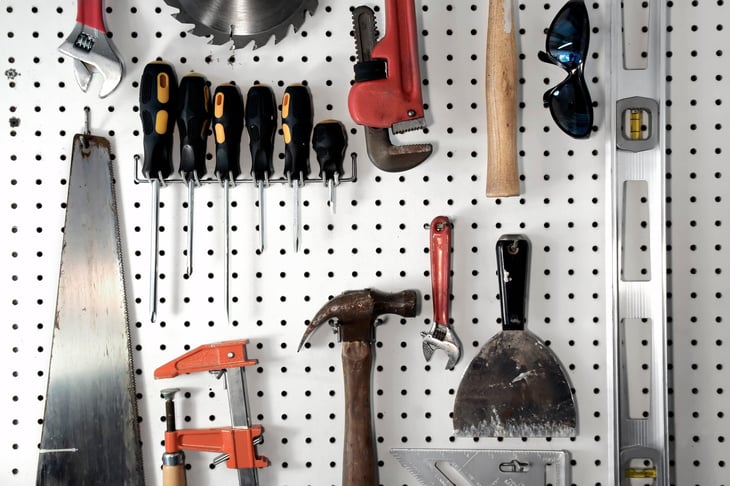
Editor's Note: This story originally appeared on Living on the Cheap.
This year, resolve to make a change that will put more change in your own pocket.
Look at your financial goals for the new year, and make this the year you save money with your New Year’s resolutions. Don’t know where to start?
Look for ways to break down larger goals into smaller manageable ones, and give yourself several weeks to turn your new plan into a habit.
If your money-saving goals improve your quality of life and you can see results that make you happier, you’re more likely to keep up with your new habits.
Here are money-saving resolutions that will help you thrive in the new year.
1. Track your spending and start a budget

If you want to save more in the new year, you’ll need to first need to find out where your money is actually going. Resolve to start tracking all your expenditures to see where you might be spending too much.
You can do it the old-school way, with these free printable sheets, or use a free online tool. Mint was the first in the free online budgeting category, but here is a list of other options.
Once you know what you’re spending, you can identify which expenses are nonnegotiable and where you can cut down on wasteful or unnecessary spending, then create a budget to guide your purchase in the months to come.
You can even teach your kids to budget if they have an allowance!
You’ll need to continue to track your spending to make sure you stick to the budget. Don’t forget to factor in paying down debt or saving for emergencies.
Creating and adhering to a budget is a terrific money-saving resolution if you’re looking to increase your savings or get out of debt.
2. Rent or borrow instead of buy

Why buy something for full price when you can rent it cheaply or borrow it for free? Make a New Year’s resolution to never buy something if you don’t absolutely have to.
Use the local library to find some good reads, rather than buying paperbacks.
Check there first for DVDs and audiobooks to borrow for free before you sign up for a subscription service or pay a rental fee.
Engage with your community to rent or borrow

Got a home improvement project? See if a neighbor can lend you his specialty tools, rather than buying that staple gun or spray washer you won’t use again.
(Or borrow one from AutoZone — you pay the cost of the tool as a deposit, and you get your money back once you return it, making the loan totally free.)
Borrow a friend’s camping gear for your national park trip, or borrow a formal dress (or Rent the Runway) rather than purchasing a fancy outfit for your niece’s wedding when you have no other dressy occasions on the calendar.
Not only will you save money by buying fewer one-use items, but you might also form more connections in your community by engaging more with your neighbors.
Just remember to always return something in as good or better condition: Fill a gas-powered tool with gas or have a borrowed piece of clothing dry-cleaned. That way your friends and neighbors won’t mind lending to you again.
3. Learn a new skill

Learning keeps your mind agile and enriches your life. It can also save you money.
Community colleges, continuing education programs, parks and recreation programs and even some retail establishments offer short-term courses where you can learn skills you might otherwise outsource to a paid professional — auto repair and maintenance, sewing, dog grooming, couples massage, web and graphic design, home improvement, income tax preparation or lawn and garden care.
Class enrollment fees are generally modest and are offset many times over when you apply your new skills instead of paying an outside provider.
An auto shop class, for example, can save you $25 to $75 or more every time you change your own oil, replace a headlight or change your spark plugs, not to mention the hundreds of dollars you can save by maintaining your automobile to avoid costly repairs.
Grooming your dog at home will save you $30 to $75 or more on each grooming. Improve the hair-cutting skills you learned in 2020 and never visit the barber again.
Learn skills and save

You can save thousands of dollars by completing your own home improvement projects. Sanding our own hardwood floors cost us $400 (plus about a gallon of my husband’s sweat), while our local flooring company wanted $4,000 for the same job.
Learn to replace a toilet, put up drywall or retile a floor, and you’ll only pay material costs and not labor.
Don’t forget crafting! You can save money when you knit, crochet, decoupage, bake or otherwise craft holiday and birthday gifts rather than buying commercial goods. Bonus: Your friends and family will treasure unique items made by you more than any store-bought present.
If you can’t find a nearby class in your area of interest, search online for e-courses or tutorials.
YouTube has great home improvement tutorials you can watch for free, as well as cooking and crafting how-to’s.
4. Reduce and reuse

Reducing your resource consumption is not just good for the environment, it’s good for your wallet.
Think about the most recent nonfood items you purchased. How much could you have saved by shopping secondhand first?
A Living on the Cheap editor once found a $900 Ethan Allen dining table and chairs on Craigslist for $65.
Secondhand toys, furniture and home decor items can save you a bundle. We once discovered a $45 Pottery Barn bowl for $3 on a buy-and-sell site.
(Read our post for tips on how to get the best used furniture deals.)
Perks of buying secondhand

Make a resolution to buy as many things secondhand as you can, and you’ll quickly discover that secondhand does not mean second best.
Plus, with many items often out of stock this year, you might have more luck finding the used versions of popular buys, such as bikes or gaming systems.
Hand-me-downs don’t deserve their lowly status. My daughter and I are gleefully grateful for every bag of clothes she receives from our friends with older daughters.
In addition to buying and receiving secondhand items, resolve to resell, donate or pass along your belongings when you no longer need them.
This means taking good care of those belongings so someone else can enjoy them later.
5. Eat more meals at home

If you have kids, you’ve no doubt read about the significance of family meal times. Sitting down to a home-cooked meal gives family members an opportunity to pause from their busy schedules and connect with one another.
Eating at home is generally healthier than dining out as well.
And while it’s a challenge to feed a family of four for less than $20 at a restaurant (even a fast-food restaurant, if you include drinks), you can prepare a meal that serves four to six people for less than $10.
If you’re among the 53% of people who dine out at least once a week, make a New Year’s resolution to replace one or two restaurant meals a month with a home-cooked meal.
Designate a weekly or monthly time for planning low-cost meals. Allrecipes.com, FamilyEducation.com and the Food Network’s “Ten Dollar Dinners” provide budget-friendly recipes to get you started.
Freezer meals are also a quick and easy way to eat healthy meals hassle-free at home. Check out our Freezer Cooking 101 article for tips on how to get started.
6. Seek out free or cheap entertainment

Local communities offer all kinds of FREE entertainment – from summer movies and concerts in the park to free kid classes at nature centers and libraries.
Museums occasionally have free or half-price admission days, or ask at your local library about free museum passes for cardholders.
Local festivals can be free to attend, as long as you remember to bring your own snacks and just say no to purchases from crafts sellers and other vendors.
Choose a local trail rather than a park with an entrance fee for your day hike, or look for historic attractions with grounds you can visit free of charge.
You might have to spend some time getting on event mailing lists, or reading up on calendars of events. But the money you’ll save will make it time well spent.
7. Shop the sales and coupons

Make a vow that this will be the year you try never to pay full price for anything.
That might mean shopping the sales — everything from buying next year’s outfits during this year’s end-of-season sales to planning your meals around the discounted or manager’s special items at the supermarket.
Sign up for retailers’ emails or apps that will alert you to discounts, and save all those Bed, Bath and Beyond coupons that come in the mail (because the store will accept expired ones).
It might take a while to adjust your shopping habits, but, hey, you have all year!
8. Walk more

Trip Savvy reports that the three top New Year’s resolutions are to eat healthier, exercise more and spend less/save more. You can accomplish two of the three goals by replacing your car keys with walking shoes.
Walking will help you get in shape, save you gas money and reduce wear and tear on your car. It’s both a physical and a financial resolution!
Consider an average week and make a list of all the places you routinely drive less than a mile to reach. At a moderate speed of 3 miles per hour, you could walk to any of those places in 20 minutes.
And at the Internal Revenue Service’s mileage reimbursement rate, you’ll save 58.5 cents for each mile you walk rather than drive.
And the American Heart Association reports that physically active people save a significant amount of money on health care costs.
Walking just 30 minutes a day, according to the AHA, provides health benefits with no start-up costs or gym membership required.
9. Turn off your TV

Multiple studies have linked excessive television viewing to increased obesity, sleep problems, inactivity and unhealthy snacking.
Other studies indicate that television can be as bad for mental health as it is for physical health, increasing viewers’ depression and anxiety levels.
Reducing your television consumption isn’t just good for your health, it can pay off financially as well.
Cable and satellite television packages start at around $30 a month and can rise to $100 a month or more.
Switch off your TV to save

In addition, television viewing is linked to increased spending.
A study by economist Juliet Schor, author of “The Overspent American: Why We Want What We Don't Need,” found that each additional hour of TV viewing per week increases consumer spending by about $200 a year.
Schor attributes this effect to television advertising and its promotion of affluent lifestyles.
If you love your TV, start by making a money-saving resolution of swapping an hour of TV each week with an hour of exercise, off-screen family activities or time spent on home improvement and organization tasks you never get around to doing.
You might find you don’t miss it at all.
10. Audit your utilities

Do you have the same cellphone plan you’ve had for five years? (We do too.)
This year, do an expense audit to see if you can shave some money off your utility bills by switching to new plans or new providers.
And if you’re certain you’re willing to switch, often telling your current company that you’re going to take your business to a competitor will incentivize your provider to offer you a discount or a matching rate.
Also, ask your local utility company if they offer free energy audits. You might be able to save more on your utility bills with some inexpensive yet energy-saving fixes.
11. Simplify your life

Simplifying your life is a resolution that will save you money and eliminate the clutter – both physical and mental – from your day to day.
Take a look at what you own and pare down to the essentials, whether that’s your clothing, your toys, or your keepsakes. Look to Marie Kondo or other minimalist gurus for inspiration and advice.
How will this save you money? If you commit to owning fewer things, you will need to buy fewer things in the future.
Plus, you won’t need to spend half your paycheck at The Container Store or IKEA, purchasing storage bins, bookshelves and organization systems to keep your belongings in check and off the floor.
With less stuff, you’ll focus on what’s truly important to you and not get bogged down in distractions. Perhaps that’s spending more time with family, volunteering in your community or playing an instrument.
Your newly non-messy house will be easier to take care of and cause you less stress. And you won’t need to waste time chasing deals or shopping for things when you’re only willing to own what’s truly necessary. Happy New Year!





Add a Comment
Our Policy: We welcome relevant and respectful comments in order to foster healthy and informative discussions. All other comments may be removed. Comments with links are automatically held for moderation.